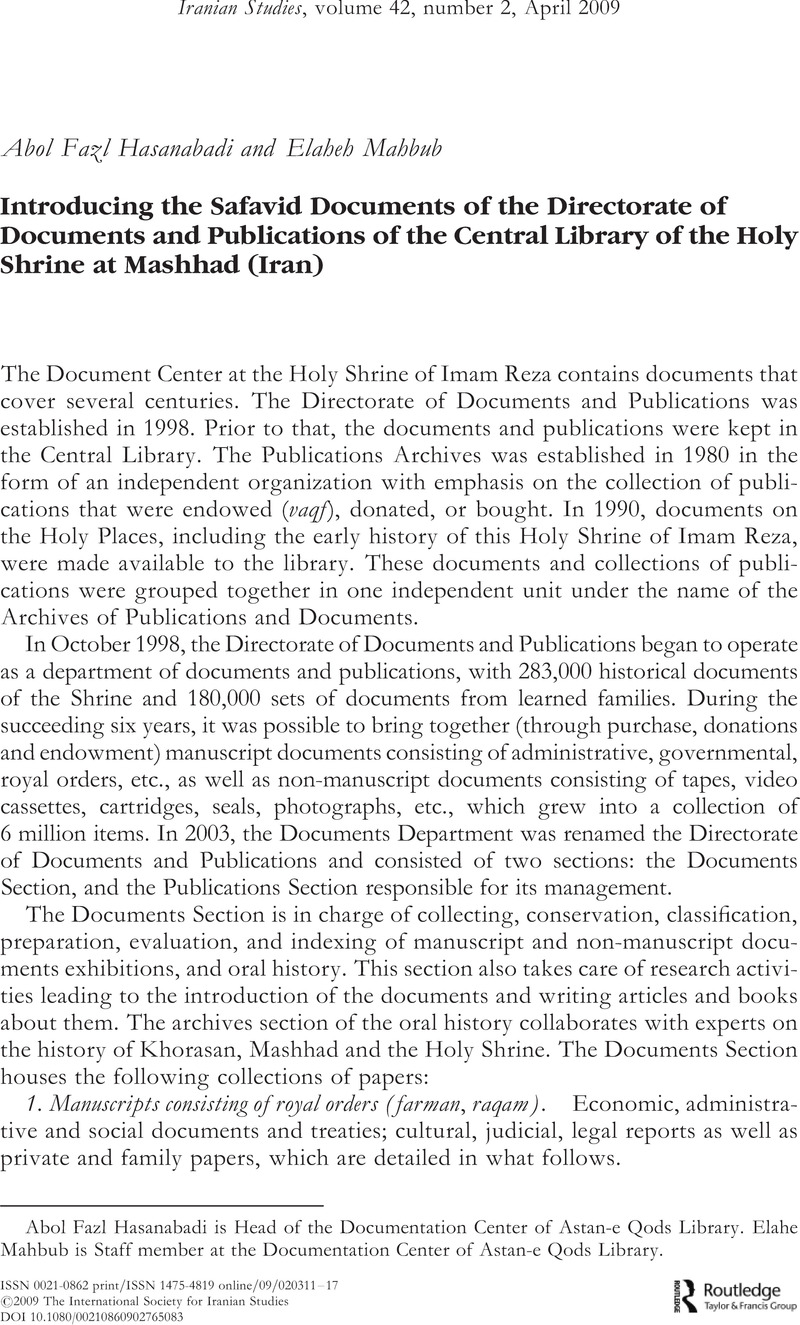Article contents
Introducing the Safavid Documents of the Directorate of Documents and Publications of the Central Library of the Holy Shrine at Mashhad (Iran)
Published online by Cambridge University Press: 01 January 2022
Abstract

- Type
- Articles
- Information
- Copyright
- Copyright © The International Society for Iranian Studies 2009
References
1 For further information about our Center see http://www.aqlibrary.org, 71–70 ![]() .
.
2 Mohsen Jafari, Mazhab, “Gorjestanat in Ottoman Documents,” Book of the Month Journal: History and Geography, 70–71 (2003)Google Scholar: 80–83, 1382  71–70
71–70 ![]() .
.
3 For further information about the Safavid documents see Book of the Month Journal: History and Geography, Special Issue on Safavid Studies, 70–71 (August–September 2003).
4 A set of documents that refer to economic sources. In this document record of all the Astan-e Quds incoming avarejeh has two sub-branches, namely abvabalmal and arbab althavil and althasi.
5 A set of documents that refer to the Astan-e Qods expenses in different areas of income (wujuhat) were often categorized under sub-branches such as marsum, mavajeb, jireh, etc.
6 In the Safavid era the Astan-e Quds received some assistance from the central government in the form of grant farms, gardens, etc. frequently referred to as syrourghal.
7 The term kehik refers the group of persons that work in the Holy Shrine of Imam Reza and perform duties such as cleaning the ravagh and other places of the Holy Shrine. The sarkeshik is the head of the keshik (guard) while the khadembashi is regarded as the deputy. Other staff include the moddaress, the khodam, the farrash, the darban, the kafshban and the moazen.
8 For more information about the organization of the Astan-e Quds Razavi during the Safavid era, see Abolfazl Hassanabady's short history of the Astan-e Quds Razavi during the Safavid period published in the Book of the Month Journal: History and Geography. Special Issue on Safavid Studies, 6, no. 10–11 (August–September 2003).
9 Mahazari was a small meal given to the staff of the Astan-e Quds during the Safavid period.
10 Marsum mavajeb and mostamarri were various kinds of payment that were paid to the Astan-e Quds. Some of the staff were given mavajeb, others marsum and yet others were granted mostammarei. No comprehensive research has been done on the subject and the author hopes to conduct further research on the subject based on available documents in the Astan-e Quds.
11 Special ceremony held on 3rd of Sha'ban, 15th Sha‘ban[0], in the holy shrine.
12 Mohaseban worked in the daftarkhaneh (book keeping section).
13 Refers to individuals who guard the Astan-e Quds farmers.
14 He was the person whose duty was to hold the key, particularly the key of the zarih mottahar.
15 Steward or nazer was an important job in the Astan-e Quds. He was often the second in charge of the mottavalian, during the Safavid period.
- 2
- Cited by




